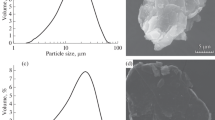Conclusions
-
1.
The friction process in a metal-refractory compound pair is accompanied by intense adhesion of the metal to the mating surface, which leads to cold welding between the transferred metal and the metal specimen and to particles of the harder refractory compound being torn out.
-
2.
The high degree of deformation of the cubic metals promotes the formation on the friction surface of a hard and tenacious layer which acts mechanically upon the surface layer of the refractory compound; this, combined with the tangential stresses set up as a result of the adhesion, results in severe wear of refractory compounds, which is greater than that observed when these compounds slide on themselves.
Similar content being viewed by others
Literature cited
A. A. Starosel'skii and D. N. Garkunov, Useful Life of Rubbing Machine Components [in Russian], Mashinostroenie, Moscow (1967).
M. B. Peterson and R. E. Lee, Wear, No. 7, 334 (1967).
E. Rabinowicz, Metals Eng. Quart., Am. Soc. Metals,7, No. 2, 4 (1967).
B. D. Voronkov, Dry Friction Bearings [in Russian], Mashinostroenie, Leningrad (1968).
V. I. Alekseev and M. S. Koval'chenko, Fiz. -Khim. Mekhan. Mat., No. 3 (1971).
V. I. Alekseev, M. S. Koval'chenko, and Yu. P. Vertebnyi, Zavod. Lab., No. 12 (1970).
T. N. Loladze, Wear of Cutting Tools [in Russian], Mashgiz, Moscow (1958).
A. N. Reznikov, in: Machining of Heat Resistant Alloys [in Russian], Izd-vo AN SSSR (1960), p. 162.
S. N. Filonenko and N. S. Molodtsov, Tekhnol. i Organizatsiya Proizv., No. 1, 44 (1969).
D. H. Buckley, Am. Soc. Lubrication Engr. Trans., No. 10, 134 (1967).
G. V. Samsonov, L. V. Strashinskaya, and É. A. Shiller, Izv. Akad. Nauk SSSR, Otd. Tekhn. Nauk, Met. i Toplivo, No. 5, 167 (1962).
R. F. Voitovich, Refractory Compounds (Thermodynamic Characteristics) [in Russian], Naukova Dumka, Kiev (1970).
Author information
Authors and Affiliations
Additional information
Translated from Poroshkovaya Metallurgiya, No. 11 (131), pp. 94–98, November, 1973.
Rights and permissions
About this article
Cite this article
Alekseev, V.I., Koval'chenko, M.S. & Serebryakova, T.I. Friction in transition metal-refractory compound pairs. Powder Metall Met Ceram 12, 938–941 (1973). https://doi.org/10.1007/BF00794636
Received:
Issue Date:
DOI: https://doi.org/10.1007/BF00794636




